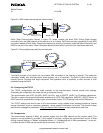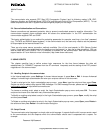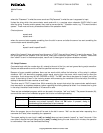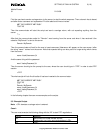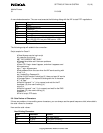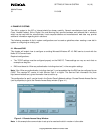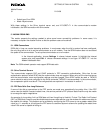
SETTING UP DIAL-IN SYSTEM 7 (16)
Mobile Phones
3.1 21.04.99
Copyright©Nokia Mobile Phones 1999
There are several special character sequences which can be used with scripts. The table below will describe them.
Sequence Description
"" Expect or send nothing. The sequence will be followed by a carriage return.
/s Send or receive a space character (ASCII 0x20)
/t Send or receive a horizontal tab character (ASCII 0x09)
/n Send or receive a line feed character (ASCII 0x0a)
/r Send or receive a carriage return character (ASCII 0x0d)
// Send or receive a slash character (ASCII 0x5c)
/^ Send or receive a carat character (ASCII 0x5e)
^<character> Send or receive the single character Ctrl-<character> (ASCII 0x00 through 0x1f)
/ddd Send or receive a character specified in octal digits
/p Pause for 0.25 seconds before proceeding (send only)
/d Delay for 2.00 seconds before proceeding (send only)
/c Don't append a carriage return character after sending the preceding string
(send only)
/q Don't print following send strings (e.g. a password) in any debugging or logging
output. Subsequent /q sequences toggle `quiet' mode.
/A Parse the incoming string as an IP address, written as four decimal numbers
separated by periods, and use it for the local end of the point-to-point connection
(receive only).
/D Parse the incoming string as an IP address, written as four decimal numbers
separated by periods, and use it for the primary name resolver during this
connection (receive only).
3.4. How to Create a Script
If you do not know what kind of responses are requested by the dial-in server, there are few ways to find that out.
One can try out to make a Terminal call to the dial-in number and see what the server requests.
The other way is to go to the communicator Internet access settings where you can select a script (as described in
Handling scripts in the communicator). At the Login customisation screen, instead of picking a script you can
select "Manual". This option will bring up a terminal screen in the login sequence.
When you have found what the dial-in server requests then you can start building a script. First it is important to
add the ABT, abort strings, in case of problems. Then the timeout value should be set. After this it is time for the
server responses and what the communicator should reply. Let's take an example. This is what the server
requests:
Sender Message
IAP Welcome!<CR>
User <CR>
IAP Domain:
User MyDomain
IAP Login:
User Myusername<CR>
IAP Password:
User 2secret4u<CR>
IAP Server-prompt>
User PPP
IAP (begins PPP)






